Cozze alla Marinara - Mussels Marinara
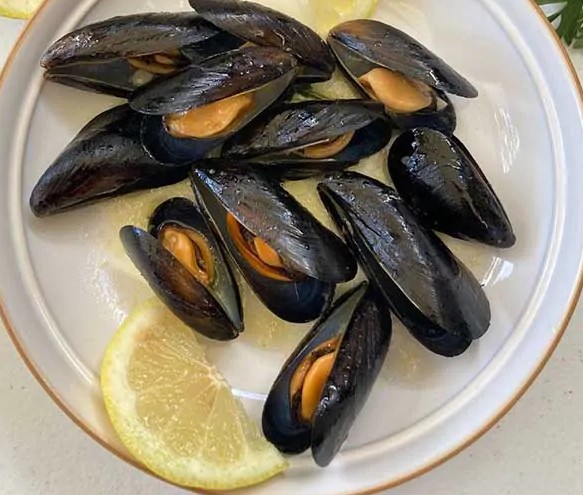
Ingredients:
- 2 kg (about 4 pounds) of mussels with shells
- 2 cloves of garlic
- 5 tablespoons of extra virgin olive oil
- 100 ml (1/2 cup ) of dry white wine
- a bunch (1/3 cup) of fresh parsley
- To prepare this Italian seafood recipe, start by cleaning mussels.
Clean the mussels by scraping off any impurities with the blade of a small knife. Tear off the byssus, that is the bearded part that comes out of the shell. Then, with the help of a stainless steel sponge, clean well their shells. Remove algae and sand residues and encrustations. Discard any broken or hatched mussels.
Then rinse the mussels quickly under running water, to remove all impurities. But do not let them soak in water for long. - Now prepare the parsley and garlic. Depending on your taste, you may decide to chop both finely or leave them whole and remove them before serving the mussels.
In a large nonstick skillet, pour the extra virgin olive oil and heat it over medium heat. Add the garlic and sauté for about 1 minute. - Add the mussels. Stir and move them around so that the heat reaches them evenly.
As soon as you see the mussels begin to hatch, which will take a couple of minutes, pour the dry white wine. - Finally add the parsley. Chopped or whole as you prefer.
Cover with a lid and let all the mussels fully open.
PLEASE NOTE: If the mussels are not well spaced in the pan, but overlapping and therefore opening cannot take place at the same time we give you some useful tips. Either pull the mussels out of the pan as the shells hatch or cook the mussels a few at a time or in two pans. This is because overcooking risks making the mussels hard and rubbery. - When the mussels are all open, leave them on the heat for another 2 to 3 minutes.
Transfer the mussels to a serving plate and drizzle them with their filtered cooking sauce.
Serve the mussels marinara immediately with slices of homemade bread and some lemon slices.
What Can You Use Mussel Broth For?
When you cook mussels alla Marinara, you may notice that as the mussels open, they release a lot of water.
This water, together with oil, garlic and parsley, forms a delicious sauce in which to dip slices of homemade bread. A real delicacy!
Our tip is to save the water that will surely remain in the pot and that you will not consume completely.
Mussel water is in fact a precious water. You can add it to broths and fish recipes by enhancing their flavor.
Mussel water is indeed a concentrate of flavor, but it can be full of impurities. There may be residual sand that settles to the bottom of the pot. Or pieces of garlic or parsley or even pieces of shell.
Therefore, it’s best to strain the mussel water through a very fine-mesh strainer or cotton cloth.
You simply put it in an airtight jar and store it in the refrigerator for up to 3 days. One method of storing it longer is to place it in the freezer. This way you can keep it for up to 2 months. This way you will always have mussel water on hand to prepare your seafood recipes with an extra twist!
How you can serve the Mussels Marinara?
You can serve mussels marinara as an appetizer or as a main course. The difference is only the quantity. Serve with slices of fresh or toasted bread.
They are often used to dress pasta, usually long formats such as spaghetti or linguine. In this case, we recommend that you shell the mussels and keep some with the shell on to decorate the dish. We also recommend that you finish cooking the pasta in the mussel sauce for a richer flavor.
Cozze alla Tarantina
In Puglia there is a variation called “Cozze alla Tarantina” that adds fresh tomatoes and lots of chili pepper.Impepata di Cozze
If you add a lot of ground black pepper you get the very famous Neapolitan “Impepata di Cozze.”Zuppa di Cozze
Or, leaving it more brothy, you get a “Zuppa di Cozze” accompanied by generous croutons of bread.Marinara soup of mussels and clams together
In Emilia Romagna it is customary to prepare a marinara soup of mussels and clams together.Reference:
https://www.recipesfromitaly.com/mussels-marinara-recipe-cozze-alla-marinara/
Stufato di calamari in salsa di pomodoro con bruschetta all'aglio - Calamari Stew in Tomato Sauce with Garlic Bruschetta
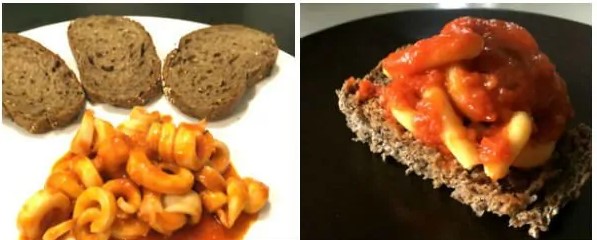
Ingredients:
- 3 fresh squids mid size (about 500g / 1,1 lb)
- 1 small onion
- 400 ml (1 ¾ cup) of tomato passata
- 100 ml (½ cup) of dry white wine
- 12 slices of bread
- 3 garlic cloves
- extra virgin olive oil
- salt and pepper
- Clean the squids carefully. Remove the entrails, the central cartilage and skin, then rinse under running water. Cut calamari in the length direction, so to obtain long strips of about 1cm in width. These calamari strips will curl during cooking, forming some nice curls similar in shape to fusilli pasta. This way the sauce will stick better to the squids than with traditional calamari rings.
- In a large pan put extra virgin olive oil, the chopped onion and two cloves of garlic. Cook for about 5 minutes over low heat. Then add the calamari strips. Raise the heat, sprinkle with white wine and let it evaporate.
- Now add the tomato passata, salt and pepper and let simmer for about 20 minutes, until the calamari are curled up and become tender. Remember to remove the garlic before serving.
- Serve Calamari Stew in Tomato Sauce with Garlic Bruschetta (see below) as a main dish or put the calamari sauce over some small garlic bruschetta and serve them as appetizer during dinner or during a party buffet.
- Garlic bruschetta is a starter and a snack very popular in Italy. It’s based on toasted bread (in the oven or with the toaster) rubbed with garlic and topped with extra virgin olive oil and salt.
Reference:
https://www.recipesfromitaly.com/calamari-stew-with-tomatoes/
Calamari con Piselli- Squid with Peas
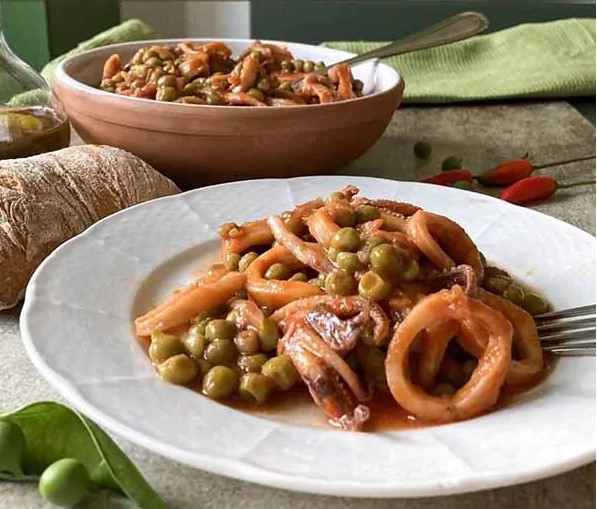
Ingredients:
- 500 g (1,1 pound) of cleaned squid (frozen or fresh)
- 450 g (2 cups) of shelled green peas
- 150 ml (1/2 cup) of dry white wine
- 350 ml ( 2/3 cup) of Tomato Passata
- 2 cloves of garlic
- 1/2 medium onion
- 4 tablespoons extra virgin olive oil
- 1 fresh red hot chili peppers or dried red hot chili pepper (optional)
- salt and pepper
Method:
- Note: You can use fresh or frozen calamari. If you are using frozen squid, remember to defrost them in the refrigerator at least a few hours ahead of time. Either way, you need to CLEAN THE SQUID before you start cooking them. You can buy them already clean, ask the fishmonger to clean them for you or clean them yourself. In this last case, carefully read the paragraph below “How to Clean Calamari”.
If you use FREASH PEAS you’ll obviously have to shell them and rinse them. Furthermore they have a longer cooking time than frozen ones, so follow carefully the instructions below.
If you want to make the recipe for Squid and Peas “in Bianco” (that is WITHOUT TOMATOES), then skip step number 4.
Once you have cleaned the calamari (read the paragraph below “How to Clean Calamari”): if they are medium to large in size like ours, cut them into rings or pieces and set aside. Otherwise, if they are baby squid, you can also leave them whole. - In a fairly large skillet, heat the oil with two peeled garlic cloves. After about two minutes, add the thinly chopped onion. Sauté over low heat until the onion is soft and translucent.
- Then add the squid. Cook along with the onion and garlic to flavor them, for a few minutes, stirring occasionally.
If you’re using fresh peas like we did, add them now. If you’re using frozen or canned peas, however, add them 10 minutes before the end of cooking time (step 5).
Now add the white wine, stir and let it evaporate. Finally, remove the garlic cloves and add the hot chili pepper (optional). - Now add the tomato passata and mix all well.
- Add a little fine salt to taste and a little freshly ground black pepper. Stir and lower the heat. Cover with a lid and simmer for about 30 minutes until the squid is tender. The squid should not overcook or it will become hard and rubbery.
If using frozen or canned peas, add them 10 minutes before the end of cooking. - After about 30 minutes, the squid with peas are ready. Taste and season with salt if necessary. Let them rest for a few minutes before serving.
Squid with Peas without Tomatoes
Squid with peas without tomatoes (Calamari con Piselli in Bianco) is a more popular recipe in northern Italy, especially in the Veneto region.
It’s a drier dish than calamari with tomato sauce, often served as an appetizer or second course accompanied with a side of mashed potatoes.
The recipe for Calamari and peas with no tomato is the same as the one we described above, without step number 4. If the squid gets too dry during cooking, add a little water.
For a more aromatic touch, you can add brandy instead of white wine.
Add some grated lemon zest before serving the dish for a fresh touch!
You can even enjoy squid and peas without tomato sauce at room temperature, especially during hot weather as a summer dish.
Calamari with Peas and Fresh Tomatoes
Instead of the tomato passata, you can also use fresh tomatoes, preferably cherry.
Cut the cherry tomatoes in half and add them during step 4. If the squid gets too dry during cooking, add a little water.
Calamari with Potatoes and Peas
Calamari with potatoes and peas is another classic Italian recipe.
Follow the steps in this recipe carefully and add the raw potatoes cut into pieces when adding the peas. The cooking time for fresh peas and potatoes is about half an hour, for potatoes cut into walnut-sized pieces.
Also, for this recipe you can add tomato sauce or go without. So decide whether to skip step 4 or not.
Seppie con Piselli - Cuttlefish with Peas
Cuttlefish with Peas is a very famous Italian recipe, hard to find abroad. This is due to the difficulty of finding cuttlefish in many foreign countries. But don’t worry because this is the recipe you need to make, whether you use cuttlefish, baby cuttlefish, squid, baby squid or giant squid!
Squid and cuttlefish are very similar, but they are not the same. They are cephalopod mollusks. Both have 10 oral arms, 2 of which are longer. The body of the squid is more tapered, while the cuttlefish has a wider body.
Squid and cuttlefish are widely used in Italian and Mediterranean cuisine. We cook them in many ways: stuffed, grilled, fried or stewed.
Cuttlefish are also used for the black ink they have to make pasta or risotto “Al Nero di Seppia”.
Reference:
https://www.recipesfromitaly.com/squid-with-peas-recipe/
Baccalà alla Livornese | Salt Cod and Potatoes in Tomato Sauce
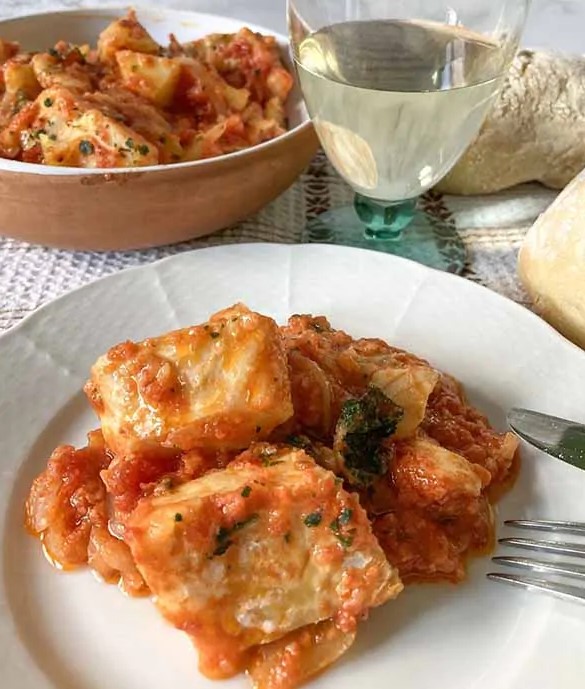
Ingredients:
- 800 g ( 1,3 lb) of Salt Cod
- 2 big potatoes
- 100 g (1 cup) of “00” flour
- 100 ml (1/2 cup) of dry white wine
- fine salt
- freshly ground black pepper
- 8 tablespoons of Extra Virgin Olive Oil
- 400 g (1 1/2 cup) of tomato passata or 600 g (2 cups) of peeled tomatoes
- 1 medium onion
- 1 clove of garlic
- 2 tablespoons of chopped fresh parsley
Method:
- PLEASE NOTE: If you have codfish still with salt, you CANNOT use it immediately. We recommend 2 to 3 days of soaking in water before cooking it (read the paragraph below ” How to Desalt Baccala”).
- To make Baccalà alla Livornese, first of all clean and slice the onions quite finely. Then peel the potatoes and cut them into cubes of about 3 cm (1/3 inch). Set the potatoes aside.
- In a pan heat 4 tablespoons of olive oil, add the whole garlic clove and the onion slices. Add 2 or 3 tablespoons of water and cover with the lid. Cook over low heat for about 5 minutes, until the onion has softened.
- Now add the tomato passata or peeled tomatoes and a pinch of salt for flavor. Stir and cover with a lid. Cook over low heat for 15 minutes.
- While the tomato sauce is cooking, start preparing the fish. First DESALT THE CODFISH reading the paragraph below “How to Desalt Baccala”.
Cut the desalted cod into slices of about 5 cm (2 inch). Carefully flour the pieces of salt cod on each side.
It’s not necessary to remove the skin of the Baccala. The skin is very thin and free of scales and helps keep the fish together during cooking. - Now heat 4 tablespoons of oil in a large pan. The pan should be quite large because it needs to accommodate the fish, tomato sauce and potatoes.
Place the cod, browning it on both sides. Turn it gently then add ground black pepper to taste. Add the white wine and let it evaporate over medium-high heat. - After about 15 minutes the tomato sauce is ready. Remove the garlic and pour the sauce into the pan with salt cod. Cover with lid and cook on medium heat for about 10 minutes.
- Add the diced potatoes then cover and cook over low heat for about 30 minutes. Stir very gently so the fish do not flake. If the sauce is too dry, add half a cup of water.
- After about 30 minutes the cod is cooked, the sauce reduced and the potatoes soft. Your Baccalà alla Livornese is ready! Turn off the heat, taste and add a little salt if necessary. Finish with 2 tablespoons of fresh chopped parsley and serve hot.
Tips:
If you have codfish still with salt, you CANNOT use it immediately. We recommend 2 to 3 days of soaking in water before cooking it. Here’s how to do it.
First, remove excess salt from the surface of the salt cod.
Rinse the fillets in cold water for 10 minutes. Prepare a large bowl or container by filling it with cold water.
Depending on how salty and intense a flavor you want, soak the fish for 2 to 3 days. Make sure it is fully submerged with enough water to cover the fish.
Remember that the longer it’s soaking, the more delicate the flavor becomes. It would be best to change the water 2 or 3 times a day.
If you buy cod already desalted, just rinse it a little in running water and it’s ready to use.
Baccalà alla Napoletana
The method does not differ much from Baccalà alla Livornese. After having floured the pieces of codfish, you must fry them in plenty of seed oil. Then add them to the tomato sauce with Gaeta capers, olives and oregano. Without the addition of potatoes.
Salt Cod alla Romana with Tomato Sauce
Besides the slice of fried cod, in Rome there is also an excellent recipe of codfish with tomato sauce. The method is similar to the Livornese recipe. The particularity of this recipe is the addition of pine nuts and raisins to the tomato sauce.
Sicilian Salt Cod Recipe
The Sicilian recipe for Baccalà differs from the one from Livorno because of the higher quantity of potatoes and the generous addition of black olives and hot chilli peppers. In some parts of Sicily pine nuts and raisins are also added.
Cod fish dictionary:
Baccalà means salted cod fish.
Merluzzo means fresh cod fish.
Stoccafisso means stokfish when it’s air cured.
Reference:
https://www.recipesfromitaly.com/baccala-alla-livornese/
Sarde a Beccafico - Sicilian Stuffed Sardines
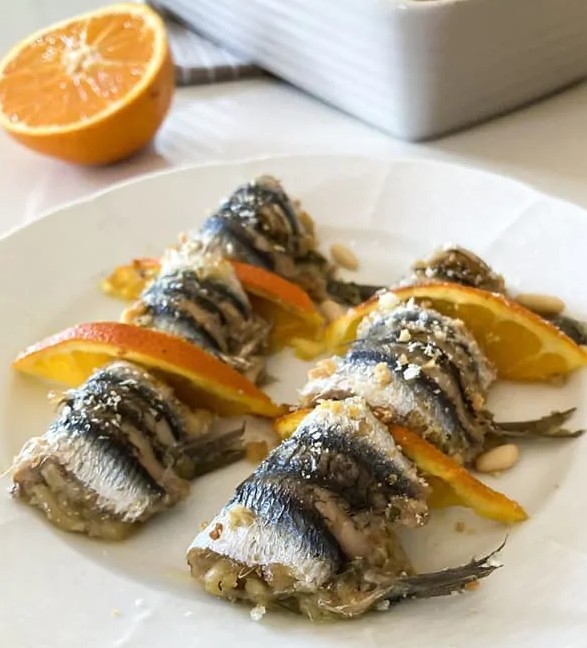
Ingredients:
- 500 g ( 1,1 lb) of sardines
- 150 g (5,3 oz) of bread crumbs
- 1 teaspoon of sugar
- 50 g (1,7 oz) of raisins
- 50 g ( 1,7 oz) of pine nuts
- 1 bunch of parsley
- 2 oranges
- 5 tablespoons of extra virgin olive oil
- fine salt to taste
- few bay leaves
Method:
- First of all clean the sardines. If you bought them already clean, so much the better. Otherwise, follow the next steps: we are going to teach you how to clean sardines to make the best Sarde a Beccafico you have ever eaten!
On a cutting board place one anchovy at a time and with a sharp knife first slit open the belly and remove the entrails. Then cut off the head and finally remove the spine. Detach the spine very gently but let the tail intact. - Rinse under running water then open them being careful not to break the anchovies. Pat with kitchen paper to dry out the water. Set aside.
- With a little stale bread, make bread crumbs. For the complete recipe full of information and tips see How to Make Homemade Italian Bread Crumbs.
Then, in a frying pan, toast the bread crumbs with a tablespoon of extra virgin olive oil and a pinch of fine salt. Stir often or the bread crumbs risk sticking to the pan. - Transfer the bread crumbs to a large bowl. Add a teaspoon of sugar, the raisins – previously soaked in warm water for about 30 minutes – the pine nuts, the chopped parsley, a pinch of fine salt to taste, the juice of half an orange and some of its grated rind.
Mix everything well. The mixture must be compact. If not, add a little more orange juice. - Now stuff the sardines: put a knob of filling at the base of the sardine, on the side where there was the head and roll it up, leaving the tail in view.
- Finish filling all the sardines. Then take a baking sheet, grease it with about two tablespoons of extra virgin olive oil and place the sardine “rolls” on it very gently.
Pour the juice of half an orange and complete with a drizzle of extra virgin olive oil and a pinch of fine salt. - Alternate the sardine rolls with bay leaves and very thin slices of orange, inserted between a row of sardines. If you have leftover filling, you can sprinkle it on the surface. If not, you can use just a little bread crumbs.
Bake at 180°C (350 F) for 20 minutes. Remove from the oven: Sarde a Beccafico is ready! Better if served cool.
Messina Sarde a Beccafico
In Messina, sardines, after being stuffed and fried, are stewed for a few minutes in tomato sauce.
Catania Sarde a Beccafico
In Catania, on the other hand, the filling also includes Caciocavallo cheese and capers, and the sardines are not rolled up but placed on top of each other two by two, then breaded and fried.
Sarde a Beccafico as skewers
So pierce rolled sardines with a stick; alternate them with bay leaves, onion wedges and/or other vegetables. Finally bake them as usual.
Reference:
https://www.recipesfromitaly.com/sarde-a-beccafico-recipe/
